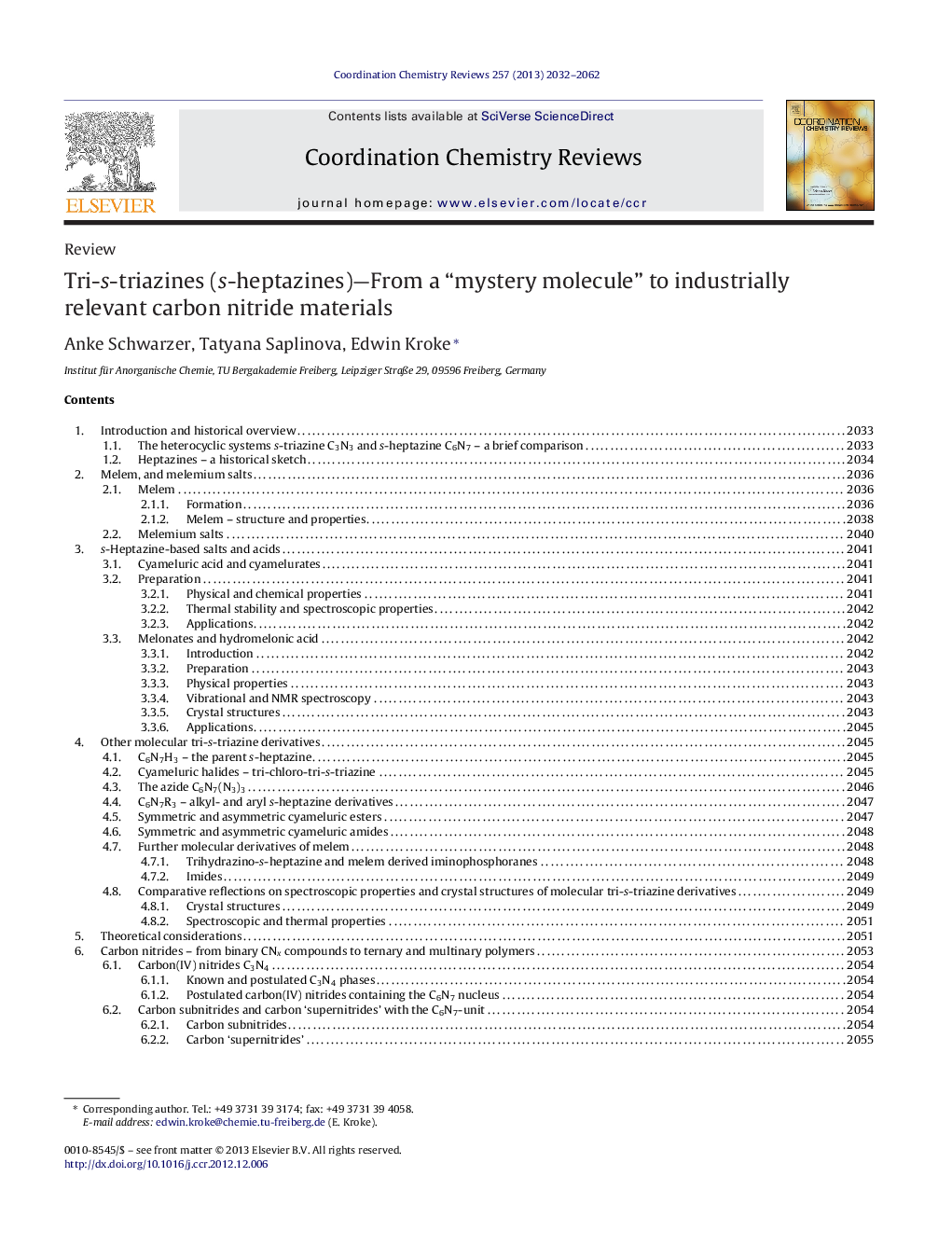| کد مقاله | کد نشریه | سال انتشار | مقاله انگلیسی | نسخه تمام متن |
|---|---|---|---|---|
| 1301059 | 1498759 | 2013 | 31 صفحه PDF | دانلود رایگان |

This review provides a comprehensive overview about the fascinating history and chemistry of s-heptazines in its ionic, molecular and polymeric forms – their synthesis, structure, properties and (potential) applications. The very stable aromatic s-heptazine (tri-s-triazine) C6N7 moiety has been discovered as early as in the 1830s, when Liebig, Berzelius and Gmelin independently synthesized the first s-heptazine derivatives. However, the correct tricyclic molecular structure was first proposed by L. Pauling about 100 years later. He obviously was intrigued by selected C6N7-derivatives until he died since the structure of a so-called “mystery molecule” C6N7(OH)2N3, which has not been synthesized so far, was later found on the chalkboard in his office. Very few s-heptazines including the parent molecule C6N7H3 (6) were synthesized and unambiguously analysed until the beginning of the 21st century. Due to the proposed ultrahardness of 3D carbon(IV) nitride networks C3N4 in the 1980/90s several researchers became interested in s-heptazines as precursors for novel carbon(IV) nitrides. Besides, in the patent literature numerous claims for the application of s-heptazines (and s-triazines C3N3X3) as flame retardants and for other applications are found. Thus, the formation, structure and properties of key molecular derivatives such as cyameluric chloride C6N7Cl3 (4), melem C6N7(NH2)3 (1), cyameluric acid C6N7(OH)3 (2), selected symmetric and asymmetric amides C6N7(NR1R2)3 − x(NR3R4)x, cyameluric esters C6N7(OR)3 and s-heptazine triazide C6N7(N3)3 (5) have been reported in recent years. In addition, various metal melonates M(I)3[C6N7(NCN)3], metal cyamelurates M(I)3[C6N7(O)3], s-heptazine-based metal-organic frameworks (MOFs) and melon [C6N7(NH2)(NH)]n were analysed in detail. Also, numerous reports on so-called carbon nitrides, which are in fact melon-related C/N/H-oligomers and polymers, have been reported recently. Although the structure of these materials is not known in detail, their properties as well as the properties of the above mentioned thoroughly analysed compounds provide a very promising outlook for various applications of carbon nitrides and C/N/H materials including s-heptazines, especially in the field of novel semiconducting materials, (photo)catalysts e.g. for hydrogen generation and carbon dioxide fixation, luminescent and in other ways optically active materials. Many of the latter characteristics have been investigated very recently and in most cases supported by experimental and theoretical studies.
► s-heptazines were discovered in the 1830s and were rediscovered in the past decade.
► s-heptazines show high thermal stability, catalytic activity and semiconductivity.
► Starting materials, e.g. melem, are obtained in large scale via one-step synthesis.
► Carbon nitrides and related materials contain s-heptazine (C6N7) units.
► Many simple s-heptazine derivatives still have not been synthesized so far.
Journal: Coordination Chemistry Reviews - Volume 257, Issues 13–14, July 2013, Pages 2032–2062